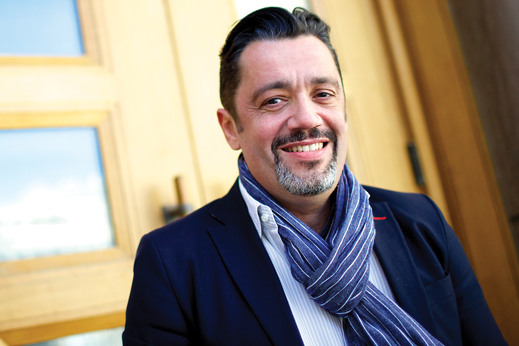The idea that a person should be an active participant, not just a recipient, of their own healthcare has deep roots. Feminists, people living with HIV and people with hemophilia have been making the case for decades: People should have control over their own bodies. We introduce you to one man who speaks from experience about the life-changing benefits of being a healthcare partner. Nine years ago, Vincent Dumez set out to transform the healthcare system so that it harnesses the skills and expertise of patients.
The concept of “managing your health” has been central to the Canadian HIV movement. From the earliest days of the epidemic many people with HIV pushed to actively participate in their own care because of experiences with a stigmatizing and paternalistic healthcare system that appeared unprepared and unwilling to care for the marginalized people first affected by AIDS. Gay men and their allies built on the feminist experience of reshaping healthcare for women that had emerged in the ’60s, as well as from a growing post-Stonewall sense of gay identity and solidarity. People with HIV took healthcare into their own hands and sought an equal and respectful partnership with their healthcare providers.
This revolutionary approach to managing your health arose in the hemophilia community at least a decade earlier in a different way—a story that is largely untold. The concept of the patient as healthcare partner—first pioneered in the world of care for people born with the genetic blood-clotting disorder hemophilia—has been central to the development of an internationally recognized model of healthcare delivery in which the patient and provider learn from each other about how best to manage a chronic disease.
Vincent Dumez, who was born with hemophilia, knows firsthand the benefits of this model of care. He has made it his mission to use the lessons he absorbed managing his own chronic diseases—hemophilia, HIV, and hepatitis C (of which he is now cured)—to champion the critical role that patients can play as healthcare partners.
As co-director of a patient-partnership program at the University of Montreal’s Faculty of Medicine, his goal is to teach patients and healthcare professionals to collaborate, learn from each other and improve the healthcare system together. Often referred to simply as the “Montreal Model,” the university’s approach has become a catalyst for real change at hospitals and universities in Canada and other countries such as Belgium, Switzerland, Italy and France. With 50 percent of North American adults now living with at least one chronic condition—and many older adults, especially people living with HIV, living with several—Dumez points out that this need for patients and care providers to work in partnership is as crucial as ever.
Growing up in the 1970s with hemophilia, Vincent Dumez was constantly in the hospital for blood transfusions to stop his bleeding. When someone with hemophilia falls or cuts themselves or bumps into something, it can take much longer for the blood to coagulate. And common surgeries, to remove tonsils or appendices, for example, can be life-threatening. “To stop the bleeding, we need transfusions,” Dumez explains. As a child with severe hemophilia, he would visit the hospital 150 to 200 times a year to deal with his bleeds.
To help Dumez live a more independent life, his healthcare team taught him and his family to give blood transfusions and to analyze his symptoms to decide whether they could transfuse at home or seek professional help. This was part of a broader trend in the ’70s whereby hemophilia clinics provided ongoing training and education to people with hemophilia and their families and made this an integral part of the care process.
By the time he was six years old, Dumez could self-transfuse. His parents, grandparents and extended family all participated in coaching and supporting him. “I gained autonomy and a sort of transfer of power,” Dumez says. “If I’ve been able to develop a normal life, it is because I have benefitted from this system, this avant-garde philosophy of care.” Eventually, he even felt confident enough to take up downhill skiing, despite the risks for someone with this condition.

Dumez was one of thousands of people with hemophilia who became infected with HIV and hepatitis C in the ’80s after receiving transfusions with blood products containing the viruses. Some 2,000 Canadians were infected with HIV and an estimated 30,000 more were infected with hepatitis C in the three years it took the Red Cross to remedy this disastrous situation. Most were hemophiliacs. More than 90 percent of people with severe hemophilia were infected with HIV or hepatitis C and more than half died of these diseases. Justice Horace Krever, who headed the inquiry into Canada’s blood system in the wake of this tragedy, called it a “nationwide public health calamity.”
The “tainted blood” tragedy destabilized the close, collaborative relationship between hematologists and their patients. People were angry about being infected with what was then a deadly, incurable virus; they were equally upset that many doctors (including Dumez’s) knew about their patients’ HIV status and chose not to tell them, in some cases for up to a year and a half following their infection. Dumez describes the advent of AIDS as “a new world” for people with hemophilia. Now this community was suddenly confronted with a fatal disease about which little was known.
Dumez experienced a sense of “profound loss” as he realized how much the partnership had been broken during that time. This sense of loss and the need to rebuild his confidence in the healthcare system spurred him to write his master’s thesis on the doctor-patient relationship and later inspired his work at the University of Montreal. He wanted to understand why so many hemophilia experts failed to communicate with their patients at the exact moment when patients needed it most, and he wanted to make sure that partnership wouldn’t fail again. “At an emotional level, I wanted to rebuild something that I lost in order to rebuild myself,” he says.
The lessons of the patient-partner model were not lost on the hemophilia community. Hemophiliacs and family members continued to come together to trade information, tips and experiences on living with these new diseases.
Meanwhile, in the larger HIV community, the need for self-care models was also becoming apparent. It didn’t take long for people living with HIV to mobilize and find ways to share critical information—on everything from which drugs were managing their symptoms to which doctors were willing to treat them. AIDS phone lines and organizations like Toronto’s Treatment Information Exchange (TIE) Project—which would later become CATIE and would publish Managing Your Health in partnership with the Toronto People with AIDS Foundation (the “bible” of the patient-partner movement)—were created to address the need for patient education. People with HIV pushed for a patient-partner model that is at the heart of HIV management today.
Dumez sums up this achievement: “We demonstrated that people living with HIV could become competent at self-care based on the experiential knowledge they acquired living with the disease every day.”
Until 2010 Dumez was so focused on his work as the co-owner of a successful strategic management company that he hadn’t given the patient-partner concept much thought for some time. But that year, he met the management team of the University of Montreal’s Faculty of Medicine and realized that they shared the same vision of what needed to change in the education of medical students. Soon afterwards, the dean proposed that Dumez spearhead a new patient partnership program.
Dumez quickly left his career as a consultant behind and took up the challenge. At the University of Montreal’s Faculty of Medicine, he founded and co-directs the Centre of Excellence on Partnership with Patients and the Public.
This program recognizes that a person’s experiential knowledge gained from living with a disease is of equal importance to the healthcare professional’s scientific knowledge. “Doctors are specialists in the disease, and patients are specialists in living with their disease,” Dumez says. “Doctors need to understand that the patient isn’t someone you push care on; the patient is someone you partner with.” The program engages patients at all levels of the healthcare system, including in the training of health professionals.
Dumez successfully pushed the University of Montreal to integrate the concept of patient partnership into courses that teach healthcare professionals how to collaborate with each other. He convinced the university to allow experienced patients to co-lead these courses, a worldwide first. Today at the university, 300 patients pair up with healthcare professionals to train students in 13 different healthcare programs how to partner with patients.
The centre first teaches experienced patients to recognize and understand the skills they’ve acquired in the course of being patients. In addition to their experiential knowledge (knowing what it’s like to live with their illnesses), some experienced patients possess highly developed communication and collaboration skills, Dumez says.
These patients then use examples from their own lives to help train students to develop these skills themselves. For instance, patients in the program help medical students debrief after their first challenging experiences working with patients in clinical settings. “Patients give them feedback and help them realize that teamwork is complex,” Dumez says. “There’s not one specific behaviour that works to deal with various complex human situations.”
Medical students not only learn to communicate and work synergistically with patients, they also learn to appreciate the perspectives of patients. They come to understand, for example, that a patient’s goals for their own treatment may be different from the goals of their healthcare providers.
After graduating from the university, med students trained in the Montreal Model enter the real world with a completely different understanding of how to work with patients. This is a revolutionary change because, in Western medicine, doctors have traditionally seen themselves as the experts who tell patients what to do, and their patients as people who should largely follow—and not question—their instructions.
Additionally, the Centre of Excellence has worked with 30 hospitals in Quebec on initiatives that give patients a seat on hospital quality-improvement committees. “Healthcare providers are discovering that patients and family members who experience the healthcare system on a day-to-day basis can have good ideas about how to improve it,” Dumez says: “It’s about time.” The Centre has also supported the Canadian Institutes of Health Research (CIHR) on how to incorporate the patient-partner concept into its strategy for patient-oriented research (SPOR). SPOR researchers are now required to engage patients to define what research should be done and how best to accomplish it.
Hospitals, universities and decisionmakers in Canada and abroad have sought the expertise of Dumez’s team in replicating or adapting the Montreal Model for their situation. “The model has been a catalyst for systemic change in healthcare delivery—change that began in the hemophilia and HIV communities,” Dumez says. “Patients have huge things to bring to the healthcare system. It’s working.”
Jennifer McPhee is a Toronto-based writer who contributes regularly to The Positive Side.
Illustration by Christine Roy
Photograph by Sarah Mongeau-Birkett

